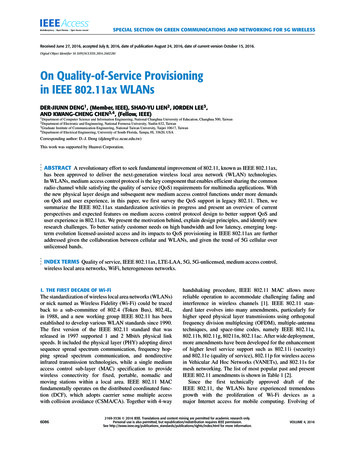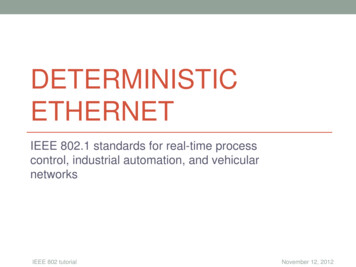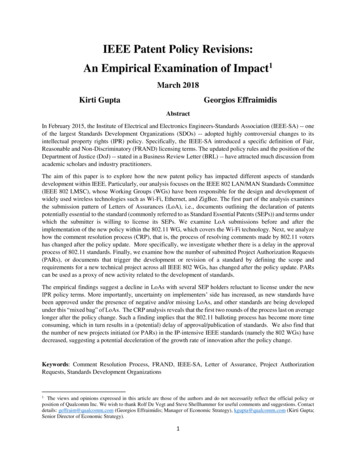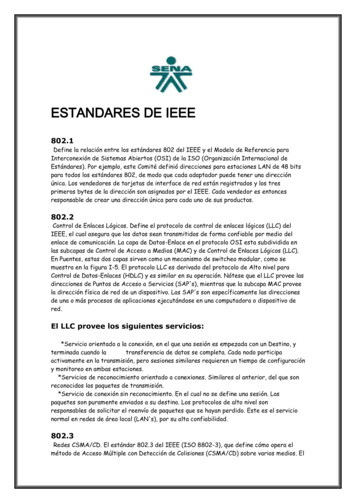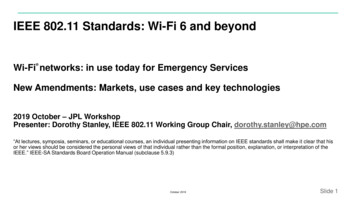
Transcription
IEEE 802.11 Standards: Wi-Fi 6 and beyond Wi-Fi networks: in use today for Emergency ServicesNew Amendments: Markets, use cases and key technologies2019 October – JPL WorkshopPresenter: Dorothy Stanley, IEEE 802.11 Working Group Chair, dorothy.stanley@hpe.com“At lectures, symposia, seminars, or educational courses, an individual presenting information on IEEE standards shall make it clear that hisor her views should be considered the personal views of that individual rather than the formal position, explanation, or interpretation of theIEEE.” IEEE-SA Standards Board Operation Manual (subclause 5.9.3)October 2019Slide 1
IEEE 802.11 systems are commonly used for emergency anddisaster recovery communicationsLiberty Global Teams to Provide Free WiFi inPuerto s Network Recovery Following NaturalDisaster: Puerto Rico after Hurricane Mariaincluding “cellular backhaul being provided abstract id 3142393October 20192
Customized products are developed usingIEEE 802.11 systems for remote connectivity,disaster management, targeting developingcountries.Example: India Centre for development ofTelematicsOctober 20193
Market demands and new technology drive IEEE 802.11 innovationDemand for throughputContinuing exponential demand for throughputMost (50-80%, depending on the country) of the world’s mobile data is carried on 802.11 (WiFi) devices802.11ax/Wi-Fi 6 – Increased throughput in 2.4, 5 (and 6) GHz bands.Increased efficiency.802.11ay – Support for 20 Gb/s rates in 60 GHz bandNew: 802.11be – Extremely High ThroughputOctober 2019Slide 4
Categories of Enhancements in 802.11ax (Wi-Fi 6)Spectral Efficiency & Area ThroughputDL/UL MU-MIMO1024 QAMw/ 8 clients25% increasein data rateHigh DensityOFDMALong OFDMSymbolSpatial Reuseacax8x8 AP2x increasein throughputUp to 20%increasein data ratePower SavingScheduled sleep and wake timesBeaconNext TWTTWT Wake r / Longer rangeVariable durations per HE-LTF symbolExtended range packet structureBeacon8µs8µsL-STFL-LTF4µs4µsL-SIG RL-SIG16µsHE-SIG-A4µsHE-STF HE-LTF.HE-LTFDataPETWT element: Implicit TWT, Next TWT, TWT Wake Interval20 MHz-only clientsEnhanced delayspread protectionlong guard interval80 MHz Capable20 MHz-only0.8us11ac1.6us 11ax3.2us 11axOctober 20195
IEEE 802.11ax meets the MAC/PHY requirements for 5G IndoorHotspot test Environment defined by IMT-2020– Analysis and simulations confirm that performance of IEEE 802.11ax MAC/PHY meet or exceed 5Grequirements for the 5G Indoor Hotspot use case– Similar studies are underway for the Dense Urban test environmentMetricITU-R Evaluation MethodMinimum Requirement802.11ax Performance1Peak data rateAnalyticalDL/UL : 20/10 GbpsDL/UL : 20.78 Gbps [Note 1]2Peak spectral efficiencyAnalyticalDL/UL : 30/15 bits/s/HzDL/UL : 58.01 bits/s/Hz [Note 2]User experienced data rateAnalytical for single band and singlelayer;Not applicable for Indoor HotspotNot applicable3Simulation for multi-layer45th percentile user spectral efficiencySimulationDL/UL : 0.3/0.21 bits/s/HzDL/UL : 0.45/0.52 bits/s/Hz [Note 3]5Average spectral efficiencySimulationDL/UL : 9/6.75 bits/s/Hz/TRxPDL/UL : 9.82/13.7 bits/s/Hz/TRxP [Note 3]6Area traffic capacityAnalyticalDL : 10 Mbit/s/m2Required DL bandwidth 170 MHz with 3TRxP/site. [Note 4]7MobilitySimulationUL : 1.5 bits/s/HzUL : 9.4 bits/s/Hz8BandwidthInspection100 MHz, scalable20/40/80/80 80/160 MHz9User plane latencyAnalyticalDL/UL : 4 msDL/UL : 80 us [Note 5]October 20196
802.11ay is defining next generation 60GHz: increased throughput andrange20Gbps rates are definedLicense- Exempt bands above 45GbpsCompletion in 2020; First chipsets announcedUse Cases: Ultra-Short Range 8K UHD - Smart Home AR/VR and wearables Data Center Inter Rack connectivity Video / Mass-Data distribution Mobile Offloading and MBO Mobile Fronthauling Wireless Backhauling (w. multi-hop) Office Docking Fixed WirelessOctober 2019Key additions : SU/ MU MIMO, up to 8 spatial streams Channel bonding Channel aggregation Non-uniform constellation modulation Advanced power saving featuresSlide 7
60 GHz Mesh Backhaul Wireless Use Case: Deploying Today“Leading Wi-Fi and wireless networksolution vendor Cambium Networksannounced today that they will beincorporating Facebook’s Terragraphtechnology into a new series of CambiumNetworks 60 GHz radio products calledcnWave . The news comes as Terragraphappears to be ramping up go-to-marketactivities with trials underway in Hungaryand most recently in Malaysia.”“Terragraph is essentially a 60 GHz-basedmeshed (or multi-hop, multi-point) backhaulradio system for deployment at street levelin -tech-intonew-60-ghz-products/October 20198
802.11be is a new amendment that builds on 802.11axExtremely High Throughput (EHT)Higher throughout – up to 30 GbpsSupport for low latency communicationsOperations in 2.4 GHz, 5 GHz, and 6 GHz bandsTargeted completion in 2023Use Cases: AR/VR 4K and 8K video streaming Remote office Cloud computing Video calling and conferencingOctober 2019Slide 9
New Usage Models/FeaturesIndoor Location802.11az – 2nd generation positioning featuresAutomotive802.11bd – Enhancements for Next Generation V2XLongerRangeInternet of Things, Low Power applications802.11ba – Wake-up RadioHigherThroughputPositioningTarget Wait Time for Low power devices (11ah, 11ax)BackwardsCompatibility802.11p seamless evolutionOctober 2019Slide 10
802.11az Next Generation Positioning Next Generation Positioning P802.11az project is the evolutionary roadmap of accurate802.11 location (FTM) appearing first in previous revisions of the 802.11 standard: Accurate indoor Navigation (sub 1m and into the 0.1m domain). Secured (authenticated and private) positioning – open my car with my smartphone,position aware services (money withdrawal). Open my computer with my phone/watch. Location based link adaptation for home usages (connect to best AP). Navigate in extremely dense environments (stadia/airport scenarios).October 2019Slide 11
802.11bd defines an evolution of 802.11p for V2X– 802.11p is largely based on 802.11a.– 802.11bd defines MAC/PHY enhancements from802.11n, ac, ax, to provide a backwardscompatible next generation V2X protocol.Longer Range– Higher Throughput–OFDM frame design–Higher MCS, LDPC coding–Packet aggregationHigherThroughput– Longer Range–Mid-amble design–Repeated transmission mechanism–More robust channel coding– Support for PositioningBackwardsCompatibility– Backward Compatibility–PositioningBackward compatible frame format design, Version indicationOctober 201912
New 802.11 Radio technologies are under development to meet expandingmarket needs and leverage new technologies 802.11ax – Increased throughput in 2.4, 5 (and 6) GHz bands. Increased efficiency. 802.11ay – Support for 20 Gbps in 60 GHz band 802.11be – Extremely High Throughput 802.11az – 2nd generation positioning features802.11ba – Wake up radio. Low power IoT applications.802.11bb – Light Communications802.11bc – Enhanced Broadcast Service802.11bd – Enhancements for Next Generation V2X Random and Changing MAC Addresses – Topic Interest Group Sensing – Topic Interest GroupOctober 2019Slide13
Wi-Fi /802.11 technologies continue to be a foundation forinnovative solutionsProject Owl: IBM-backed project Creates WiFi Network for Natural Disasters“Project Owl managed to create a live internetnetwork across one square mile using 23DuckLinks, communicating via the system inareas without cell reception.”“ .create a special Wi-Fi network spanningmore than 100 square miles that can be used toconnect victims and first responders.”October 201914
Thank YouQuestionsOctober 201915
IEEE Today at a GlanceGlobalReachTechnicalBreadth46423,000 160TechnicalSocieties andCouncilsMembersCountries1,8004,000,000 200 1,300 Annual ConferencesTechnical DocumentsTop-cited PeriodicalsActive StandardsOctober 201916
The IEEE 802.11 Working Group is one of the most active WGs in 802 Focus on link and physical layers of the network stack Leverage IETF protocols for upper layersOSI ReferenceModelIEEE 802Local and Metropolitan Area NetworksStandards Committee pp.TAGData LinkIEEE802IEEE 802.11 WG Voting Members: 300 PhysicalMediumOctober 201917
802.1 Working Group: Time Sensitive Networking, an enablingtechnology for Industry 4.0Enables ability to carry data traffic of time-critical and/or mission-critical applications overa bridged Ethernet network shared by applications having different Quality of Service (QoS)requirements, i.e., time and/or mission critical TSN traffic and non-TSN best effort traffic.Provides guaranteed data transport with bounded low latency, low delay variation, and extremelylow data loss for time and/or mission critical traffic.TSN achieves zero congestion loss for critical data traffic by reserving resources for critical traffic,and applying various queuing and shaping techniques.See .com/v/TSNIndustrial18October 2019
New 802.11 Radio technologies are under development to meet expandingmarket needs and leverage new technologies 802.11ax – Increased throughput in 2.4, 5 (and 6) GHz bands. Increased efficiency. 802.11ay – Support for 20 Gbps in 60 GHz band 802.11be – Extremely High Throughput 802.11az – 2nd generation positioning features802.11ba – Wake up radio. Low power IoT applications.802.11bb – Light Communications802.11bc – Enhanced Broadcast Service802.11bd – Enhancements for Next Generation V2X Random and Changing MAC Addresses – Topic Interest Group Sensing – Topic Interest GroupOctober 2019Slide19
Market demands and new technology drive IEEE 802.11 innovation–Demand for throughput– Continuing exponential demand for throughput (802.11ax and 802.11ay, 802.11be)– Most (50-80%, depending on the country) of the world’s mobile data is carried on 802.11 (WiFi) devices–New usage models / features– Dense deployments (802.11ax), Indoor Location (802.11az),– Automotive (IEEE Std 802.11p, Next Gen V2X), Internet of Things (802.11ah)– Low Power applications (802.11ba)–Technical capabilities– MIMO (IEEE Std 802.11n, 802.11ac, 802.11ay) and OFDMA (802.11ax)– 60 GHz radios (802.11ay)–Changes to regulation– TV whitespaces (IEEE Std 802.11af), Radar detection (IEEE Std 802.11h), 6GHz (802.11ax, 802.11be)– Coexistence and radio performance rules (e.g., ETSI BRAN, ITU-R)October 2019Slide 20
Indoor Hotspot: Wi-Fi today can meet the needs of indoor andoutdoor hotspots: for a single home user or a whole stadium ofusers2019: Super Bowl 53 smashes Wi-Fi record with 24 TBof traffic at Mercedes-Benz StadiumAverage Wi-Fi data use per connected fan also set a newrecord, with the per-fan mark of 492.3 megabytes per usereclipsing last year’s mark of 407.4.2018: a huge leap from the official 16.31 TB seen at 2018Super Bowl 52 in Minneapolis at U.S. Bank StadiumSource: Aruba/HPE, used with their permissionSource: re/wi-fi-engagements-from-super-bowl-liii/October 201921
OFDMA enables further AP customization of channel use to match client andtraffic demandsTimeTimeIncreased efficiency for (high percentage of traffic) short data frames22
Target Wake TimeSchedule Sleep and Wake Times– With the Target Wake Time (TWT) feature, an 802.11ax AP can schedule devices to sleep for long times,depending on anticipated traffic load– Devices can be scheduled to wake up individually or as a group (taking advantage of MU technologies) toquickly and efficiently exchange data before going back to sleep again– The primary goal is to reduce power consumption for battery-powered devices like smartphones and IOTsensors. In addition, OTA efficiency will improve– The AP can send data to the client device(s) at the scheduled wake-up time, or it will send out a triggerframe prior to the scheduled wake-up time to clear the channel for data from the client device23
60GHz Worldwide Spectrum Worldwide, unlicensed, spectrum availability 4 bands available in EU and Japan Recently expanded spectrum in U.S. from 57 – 71GHz, additional countries alsoconsidering expansionU.S. (57.00 GHz – 71.00 GHz)EU (57.00 GHz – 66.00 GHz)South Korea (57.00 GHz – 64.00 GHz)Japan (57.00 GHz – 66.00 GHz)Australia (59.40 GHz – 62.90 GHz)China (59.00 GHz – 64.00 GHz)Channel 3Channel 2Channel 171.00 GHz70.2 GHz68.04 GHz65.88 GHz63.72 GHz61.56 GHz59.40 GHz57.24 GHz57.00 GHzOctober 2019Channel 6Channel 5Channel 424
60 GHz Fixed Wireless Use Case: Affordable 5G Performance“the 14 GHz of contiguous spectrum in the band offers more bandwidth thanany other licensed or unlicensed mmWave band. Further, the 60 GHz band haschipsets and technology currently available on the commercial market.”“In the U.S., unlicensed mmWave frequencies available for 5G primarily cover theband from 57 – 71 GHz, called the V-Band, or 60 GHz band. This band offers 14GHz of contiguous spectrum, which is more than all other licensed and unlicensedbands combined7. This makes the 60 GHz band an excellent alternative tolicensed mmWave frequencies for smaller providers, as it can be used todeliver 5G performance for the minimal cost of available 60 GHz eless-reportOctober 201925
802.11ba Wake-up Radio: Main Use Cases include Smart Home,Industrial/warehouse and Wearables [11-17/29r10]1. Smart Home2. Warehouse3. WearablesWUP: wake-up packetWUR: wake-up receiverMR: main radio26October 2019
802.11bb: Light Communications5Gbps rates are definedLight CommunicationsUse casesUse Cases: Industrial wireless applications Medical environments Enterprise Home Backhaul Vehicle to Vehicle Communication Underwater Communication Gas Pipeline CommunicationOctober 2019Key additions : Uplink and downlink operations in380 nm to 5,000 nm band Minimum single-link throughputof 10 Mb/s Mode supporting at least 5 Gb/s, Interoperability among solid statelight sources with differentmodulation bandwidths.Slide 27
802.11bc is defining Enhanced Broadcast Services– Client end devices broadcast information to an AP, e.g. in an IoT environment, to other STAs sothat any of the receiving APs act as a access node to the eSTA 1ContentsServerAP 1NetworkSTA2APSTA 1@t T1STASTASTASTASTASTA 1@ t T2Broadcast DownlinkAP 2AP 1InternetServerZero Setup SensorInternetServerSensor on the moveAP 2Broadcast UplinkOctober 2019Slide 28
IEEE 802.11ay, 802.11ad (60GHz) and 802.11ax (2.4GHz, 5(6)GHz)technology can be leveraged to meet 5G requirements802.11ax8Gb/s (OFDMA, U/L MU-MIMO)5G Hotspot Mobile Broadband– Today’s 4G networks include 802.11technologies– For offload: “More traffic was offloaded from cellularnetworks (on to Wi-Fi) than remained on cellularnetworks in 2016” (Cisco VNI)– For Wi-Fi calling– Wi-Fi carries most public & private Internettraffic worldwide– Between 50-80% depending on country.– 5G radio aggregation technologies willnatively incorporate Wi-Fi802.11ay/aj60GHzn*20Gb/s (Aggregation MIMO)Device connectivity802.11ah (Sub 1 GHz) 11ba900 MHz Indoor IoT PANsWearables, sensors, smart home– 802.11/Wi-Fi is a Peer Radio Access Technology in the5G ArchitectureOctober 201929
802.11 and cellular radio technologies are largely complementary inmeeting the comprehensive 5G service vision WLAN access is integral part of the into the 5G system architecture developed by 3GPP 5G architecture is a functional based architecture This provides the flexibility that both core network anchoring and the RAN basedanchoring from 4G system are seamlessly supported in 5G system architecture 802.11 defined technologies – 2.4/5/6/60GHz and cellular radio technologies are essential– and largely complementary in meeting the comprehensive 5G service visionOctober 2019Slide 30
802.11/Wi-Fi is a Peer Radio Access Technology in 5G SystemUntrusted WLAN Access (3GPP Rel-15 onwards)N2Trusted WLAN Access (3GPP Rel- 16 onwards)N11AMF3GPP AccessSMFN2N3N11AMF3GPP AccessN2SMFN4N1N3IWFN3HPLMNN1IPSecN1Data NetworkUPFN3N2N4N6Y2Data NetworkUPFNon-3GPPNetworksN6N1UEN3Untrusted WLAN802.11– 5G System is Access Agnostic: UE devices canregister and access 5G services without the needof licensed based access;– Unified EAP based authentication mechanism forall accesses;–Unified transport mechanism over WLAN accessfor both trusted and untrusted use cases;–Policies based mechanism for access selectionand traffic selection, steering and splitting;–Unified QoS mechanism for both cellular andWLAN access.October 3GPPGatewayFunctionTNAPTNGFTrusted Non-3GPP AccessNetwork rusted Non-3GPP AccessNetwork (TNAN)Slide 31
IEEE 802.11 Standards: Wi-Fi 6 and beyond Wi-Fi networks: in use today for Emergency Services . 1,800 Annual Conferences 4,000,000 Technical Documents 200 Top-cited Periodicals IEEE Today at a Glance October 2019 16. The IEEE 802
